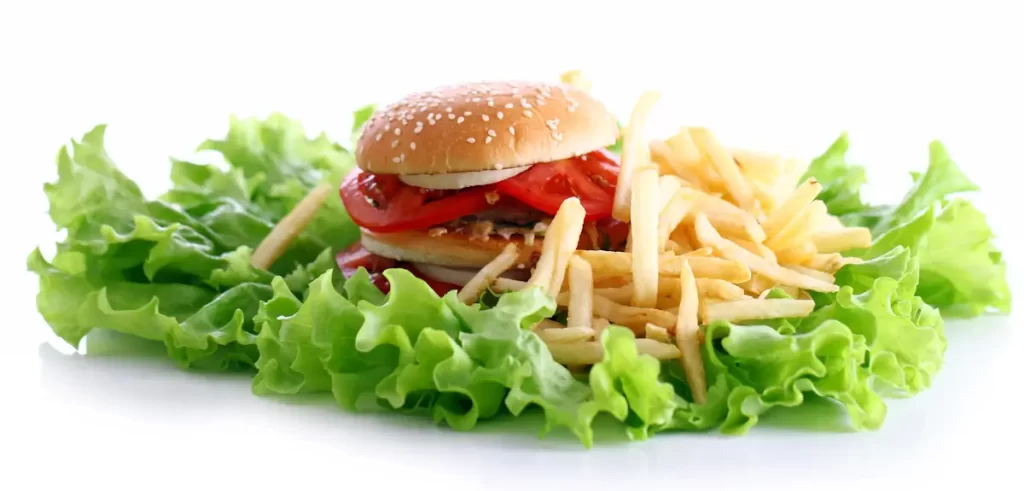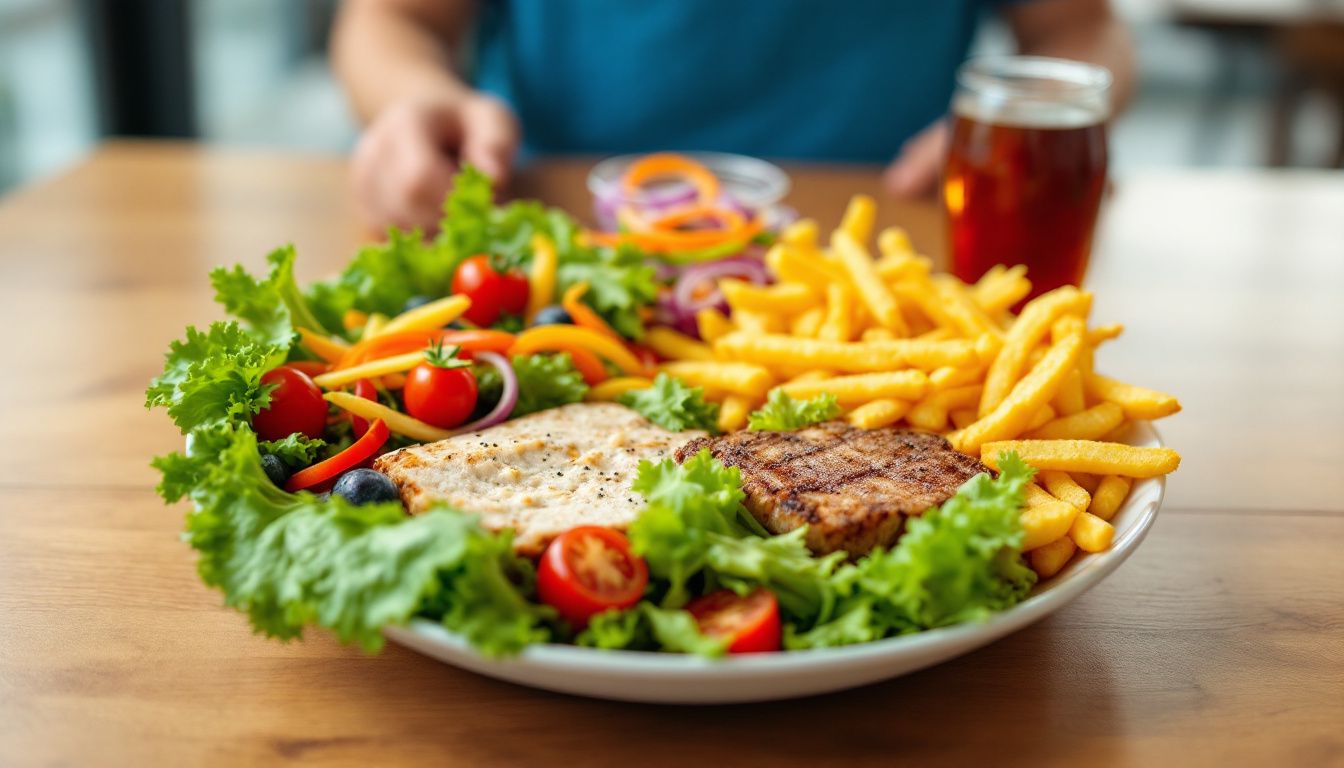Eating healthy at fast-food restaurants can feel impossible. Most meals are packed with extra calories, sodium, and unhealthy fats. This blog will show you smart swaps to make your fast food choices healthier without giving up taste.
Thank you for reading this post, don't forget to subscribe!Small changes can make a big difference—keep reading!
Key Takeaways
- Swap sugary drinks for water, unsweetened tea, or diet soda to cut calories and reduce sugar intake.
- Choose grilled items over fried foods for less fat and lower calorie meals.
- Pick smaller portions like kid’s meals to control calories and avoid overeating.
- Replace fries with a side salad or fruit cup for added nutrients and fewer calories.
- Avoid heavy sauces; use lighter alternatives like mustard, yogurt-based dips, or non-fat dressings instead.
Smart Swaps for Healthier Fast Food Choices
Making healthier choices at fast food restaurants is easier than you think. Small swaps can lower calories and boost nutrition without giving up taste.
Swap sugary drinks for water, unsweetened tea, or diet soda
Sugary drinks can add up to hundreds of empty calories in one meal. Switching to water helps cut down sugar intake significantly—by nearly three-quarters of a 1kg bag per household.
Flavored carbonated water or unsweetened tea gives you taste without the extra sugar.
Diet soda is also a low-calorie option compared to regular soda. It satisfies cravings while reducing calorie consumption. Making these swaps supports healthy eating habits and avoids risks linked to sugar-sweetened beverages, like weight gain and health problems.
“A simple swap from soda to water can transform your daily calorie count.”
Choose grilled options instead of fried items for leaner meals…
Choose grilled options instead of fried items
Grilled chicken is a healthier choice than fried. It has less fat and fewer calories. For example, grilled chicken nuggets have 266 calories and 10.5 grams of fat, while many restaurant nuggets pack about 15 grams of fat with similar calories.
Fried foods are linked to heart issues due to high unhealthy fats like trans fat. Grilled items often contain less sodium too, making them better for your diet. Opt for grilled sandwiches or baked options instead of deep-fried ones for a balanced meal low in saturated fats.
Opt for smaller portion sizes or kid’s meals
Smaller portions help control calories and prevent overeating. Many fast food meals are oversized, packing more than 1,000 calories. Choosing smaller options like kid’s meals can keep your meal under 500 calories.
These often include healthier sides like fruit cups or low-fat milk instead of soda or fries.
Kid’s meals are great for portion control without wasting food. They also cost less while offering balanced choices compared to full-size combos loaded with trans fats and heavy sauces.
This simple swap supports a healthy diet without overloading on extra sodium and sugar-sweetened beverages.
Replace heavy sauces with lighter condiments or skip them altogether
Choosing smaller portions helps, but sauces can still add extra calories. Heavy options like mayonnaise or oil-based dressings quickly increase the count. For example, fast food ranch dressing has about 110 calories and 11 grams of fat per serving.
Non-fat ranch drops to just 17 calories with no fat.
Request sauces on the side to control how much you use. Swap high-calorie choices for mustard, chili sauce, or even a drizzle of olive oil. You could also skip them completely! Lighter options, like plain yogurt-based dips or non-fat ranch (2 tbsp), are better alternatives for healthy-eating without sacrificing flavor.
Small changes—like lighter condiments—can make a big difference over time.
Swap regular fries for a side salad or fruit cup
A large McDonald’s fries has 510 calories. A medium has 340, and a small cuts that even more. Replacing fries with a side salad or fresh fruit can slash calories and saturated fat.
Salads come packed with nutrients while staying light on your plate.
Many fast food spots now offer healthier sides like fruit cups or simple greens. These choices add vitamins without extra guilt from deep frying in vegetable oil. Grabbing these instead of fried options keeps meals lighter—and still satisfying!

Tips for Healthier Fast Food Ordering
Choosing better items can make fast food meals lighter and more nutritious. Small changes, like picking dishes with extra greens or fewer toppings, go a long way.
Look for menu items under 500 calories
Fast food chains often list calorie counts on their menus. Pick meals under 500 calories to stay within a healthier range. For example, at McDonald’s, pair Chicken McNuggets with a side salad for a balanced meal.
Grilled chicken sandwiches or small veggie burgers can also fit this limit.
Skipping high-calorie sauces helps too. Items like plain yogurt or low-fat milk pair well as lighter sides or drinks. Jack in the Box offers several options that fall below 500 calories when you skip extras like cheese and fried toppings.
Always check nutritional info online before ordering!
Add extra veggies to your order for more nutrients
Choosing meals under 500 calories is a smart start. Boost their benefits by adding extra vegetables like lettuce, tomatoes, onions, or peppers. These bring more vitamins and minerals without piling on empty calories.
Veggies increase fiber and make meals feel more filling. Add spinach to sandwiches or request fresh fruit as an alternative side dish. Small changes like these promote a healthy and balanced diet while keeping the flavors fresh!
Avoid items with high sodium content
Fast foods often pack a lot of sodium. Too much salt can raise blood pressure and increase heart disease risks. The American Heart Association advises keeping sodium below 1,500 mg daily, but just one fast food burger or fried chicken meal can exceed that limit.
Check nutritional guides from chains like McDonald’s to find lower-sodium options. Skip salted fries and cheesy sauces. Instead, order fresh fruit or a fruit salad as a side. Grilled chicken over fried choices also helps cut down on hidden salt while adding healthier fats and flavors with fewer calories.
Skip the cheese or request less to reduce calories
Cheese adds extra calories and fat to meals. A single slice of cheese can have around 100 calories and 8 grams of fat. Skipping it or asking for less can make a big difference, especially at places like McDonald’s, where many items come loaded with multiple slices.
For burritos and tacos, cut back on cheese or sour cream to lighten the meal. Salads often include shredded cheese—request less or none at all. This swap lowers calorie intake while keeping your food just as satisfying if paired with fresh fruit or grilled chicken.
Understanding Vitamins and Minerals: What You Really Need
Your body needs vitamins and minerals to work right. These nutrients keep your bones strong, heal wounds, and boost your energy. Vitamin D, often found in whole milk or fortified cereals, helps absorb calcium for healthy bones.
Iron carries oxygen in the blood, while vitamin C from fresh fruit like oranges improves iron absorption.
Healthy fats like those in olive oil also play a role. They help your body use vitamins A, D, E, and K better. Magnesium from leafy greens supports muscles and nerves. Meanwhile, potassium in bananas or plain yogurt balances fluids and keeps your heart steady.
Small changes—like adding fresh fruit or swapping sugary drinks for low-fat milk—can make a big difference!
Healthier Fast Food Options by Cuisine
Different cuisines offer lighter choices if you know what to pick. Small changes like swapping ingredients or cooking methods can make meals less heavy and more nutritious.
Healthier burger options: lettuce wraps, single patties
Lettuce wraps make burgers lighter and cut carbs. Swapping buns for lettuce keeps the crunch but lowers calories. Single patties help with portion control, reducing both fat and calorie intake.
A double patty or extra cheese adds unnecessary extras to your meal.
Skipping heavy condiments like ranch dressing or mayonnaise makes a huge difference too. Stick to healthier options like mustard or plain ketchup in small amounts. These adjustments create a filling burger without all the guilt—great ideas for chicken sandwiches next!

Healthier chicken options: grilled sandwiches, baked nuggets
Grilled chicken sandwiches are a better choice than fried ones. They have lean protein and less fat, making them lighter on calories. Pair one with a fruit salad for added vitamins.
For example, Chick-Fil-A’s 4 grilled nuggets with fruit salad is tasty and healthier.
Baked chicken nuggets beat deep-fried options in nutrition. Baking cuts down on oil and unhealthy fats while keeping the flavor intact. These swaps save calories without sacrificing your favorite fast food flavors!
Healthier Mexican options: burrito bowls, soft tacos with fresh toppings
Burrito bowls skip the tortilla, cutting extra calories. They highlight fresh vegetables and lean meats like shredded chicken breast or ground turkey. Add beans for fiber—use fresh ones or rinsed, canned fat-free beans to reduce sodium.
Skip heavy cheese or sour cream; try plain yogurt as a healthy swap.
Soft tacos with fresh toppings make a lighter choice than fried shells. Use whole wheat tortillas for added fiber. Pile on veggies like lettuce, tomatoes, and chile peppers for flavor without guilt.
Stick to grilled meat and salsa instead of creamy sauces to keep it clean but tasty!
Healthier pizza options: thin crust, veggie toppings
Soft tacos loaded with fresh veggies make Mexican meals lighter. Pizza can be healthier too. Thin crust saves calories compared to deep-dish or regular crusts. Two slices of thick-crust pizza might top 600 calories, while thin options help cut that down.
Load your pizza with colorful veggie toppings like spinach, mushrooms, tomatoes, and bell peppers. These add flavor and nutrients without extra fat or sugar. Swapping mozzarella for light cheese or ricotta trims even more calories but keeps the taste intact!
Making Healthier Fast Food at Home
Try making fast food at home with simple swaps—it’s quicker and healthier than you think!
Air-fried chicken nuggets as a lighter alternative
Air-fried chicken nuggets cut down on fat without losing flavor. Compared to deep-fried versions, air frying uses less oil, making them a lighter choice. A serving of six homemade nuggets has about 266 calories, 22 grams of protein, and only 10.5 grams of fat.
The cooking process is simple and quick. Set your air fryer to 370°F and cook the nuggets for 13-15 minutes until golden brown. Use ground chicken mixed with spices, breadcrumbs, and egg for a tasty base.
This method keeps the nuggets crispy while staying healthier than fast-food options like McDonald’s deep-fried ones.
Oven-baked fries with seasoning instead of deep-fried
Swap deep-fried fries for oven-baked ones to cut calories and fat. A 3.5 oz serving of oven-roasted fries has only 149 calories, 7g of fat, and 2g of protein—much healthier than their fried counterparts.
Slice two russet potatoes into strips. Toss them with two tablespoons of avocado oil, salt, and your favorite seasoning (try curry powder or ranch seasoning). Bake at 425°F for about 25-30 minutes until crispy.
These are perfect with plain yogurt or low-fat dressings!
Homemade low-calorie dressings for dipping
Non-fat ranch dressing is a quick, tasty option with only 17 calories per 2 tablespoons. It also provides 3 grams of protein and no fat. Use nonfat Greek yogurt (5.3 oz), ranch seasoning, and skim milk to make it at home.
This simple recipe avoids the processed sugars and low-quality oils found in many store-bought dressings.
Mix plain yogurt with olive oil for a creamy dip rich in healthy fats. Add curry powder or fresh herbs for extra flavor without extra calories. You can pair these lighter dips with baked goods like oven fries or fresh fruit for guilt-free snacking!
Conclusion
Eating fast food doesn’t have to wreck your diet. Small changes, like choosing grilled chicken or skipping sugary drinks, can make a big difference. Focus on adding fresh fruit or veggies and keeping portions smaller.
These swaps are simple but help you feel better about your meal choices. Healthy eating is all about balance—small steps go a long way!
